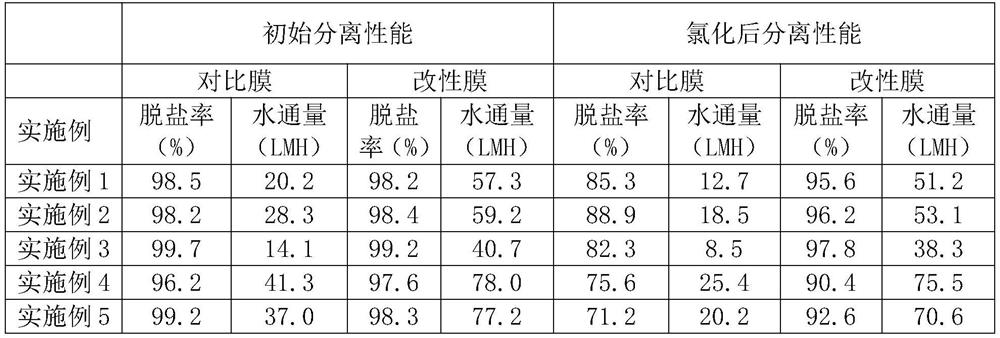Polyamide composite membrane chlorine-resistant high-flux modification method based on ketone free radicals
A free radical, polyamide technology, applied in chemical instruments and methods, membrane technology, semi-permeable membrane separation, etc., can solve the problems of energy consumption and cost reduction of nanofiltration and reverse osmosis technology, maintain salt retention efficiency, improve Chlorine resistance, easy operation effect
- Summary
- Abstract
- Description
- Claims
- Application Information
AI Technical Summary
Problems solved by technology
Method used
Image
Examples
Embodiment 1
[0022] Select the polyamide composite reverse osmosis membrane from Dow Filmtec Company in the United States, immerse it in the modification solution, and modify it at 40°C for 1h. The modification solution includes: 300 mg / L ammonium persulfate, 50% (v / v) acetone, 50% (v / v) water. After the modified solution was preheated to 40°C, the polyamide composite membrane was added, and the membrane was taken out after 1 hour of modification, and the modified membrane was fully cleaned with water before testing.
[0023] The membrane that was not treated with the modifying solution was the comparative membrane.
[0024] The test conditions of water flux and salt rejection rate are: operating pressure 14bar, flow rate 3LPM, pre-pressing the modified membrane and the comparison membrane with ultra-pure water at 25°C for 6h to stabilize the membrane performance, adjust the operating pressure to 10bar, and measure the modified membrane. The water flux of the permanent membrane and the co...
Embodiment 2
[0026] Select the polyamide composite reverse osmosis membrane from Zhongke Ruiyang Membrane Technology (Beijing) Co., Ltd., immerse it in the modification solution, and modify it at 50°C for 0.5h. The modification solution includes: 500 mg / L potassium hydrogen persulfate compound salt, 20% (v / v) methyl ethyl ketone, and 80% (v / v) water. After the modified solution was preheated to 50°C, the polyamide composite membrane was added, and the membrane was taken out after 2 hours of modification, and the modified membrane was fully cleaned with water before testing.
[0027] The membrane that was not treated with the modifying solution was the comparative membrane.
[0028] The test methods for water flux and salt rejection are consistent with those described in Example 1.
Embodiment 3
[0030] The polyamide composite reverse osmosis membrane independently developed by the inventor was selected, immersed in the modification solution, and modified at 60° C. for 2 hours. The modification solution includes: 200 mg / L sodium persulfate, 200 mg / L potassium hydrogen persulfate complex salt, 40% (v / v) acetone, 60% (v / v) water. After the modified solution was preheated to 60°C, polyamide composite membrane was added, and the membrane was taken out after 3 hours of modification, and the modified membrane was fully cleaned with water before testing.
[0031] The membrane that was not treated with the modifying solution was the comparative membrane.
[0032] The test methods for water flux and salt rejection are consistent with those described in Example 1.
PUM
| Property | Measurement | Unit |
|---|---|---|
| Concentration | aaaaa | aaaaa |
Abstract
Description
Claims
Application Information
 Login to View More
Login to View More - R&D
- Intellectual Property
- Life Sciences
- Materials
- Tech Scout
- Unparalleled Data Quality
- Higher Quality Content
- 60% Fewer Hallucinations
Browse by: Latest US Patents, China's latest patents, Technical Efficacy Thesaurus, Application Domain, Technology Topic, Popular Technical Reports.
© 2025 PatSnap. All rights reserved.Legal|Privacy policy|Modern Slavery Act Transparency Statement|Sitemap|About US| Contact US: help@patsnap.com

